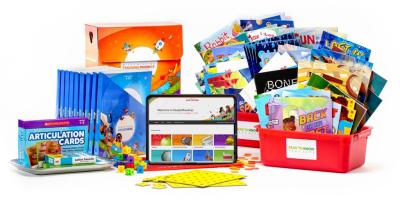Evaluation for 5.E.3d
Materials include a variety of activities and/or resources for students to practice decoding and encoding one-syllable or multisyllabic words, using knowledge of syllable types and syllable division principles, in isolation (e.g., word lists) and in decodable connected text that builds on previous instruction (e.g., within sentences or decodable texts). (PR 2.A & 2.A.3) (S)
The Wiley Blevins Teaching Phonics lessons include a variety of activities for students to practice decoding one-syllable or multisyllabic words, using knowledge of syllable types, in isolation and in decodable connected text that builds on previous instruction. For example, in Step 2 of the "Variant Vowels lesson—a, au, aw" students read words (e.g., all, call, sauce, and strawberry) from a word list in isolation by completing the activity "Blend Words: Variant Vowels—a, au, aw." Then, in Step 5 students decode words in the decodable connected text "Paws and Claws": "Use the digital or print 'Interactive Story: Paws and Claws.' Read the story with children several times. Model blending, as needed. Then have children independently complete the questions and prompts. Have children reread the story multiple times for fluency." The Wiley Blevins Teaching Phonics lessons include a variety of activities for students to practice encoding one-syllable or multisyllabic words, using knowledge of syllable types, in isolation and in decodable connected text that builds on previous instruction. For example, in Step 4 of the "Variant Vowels—a, au, aw" lesson, students practice spelling words with variant vowels in isolation and connected sentences: "Use the digital or print 'Spell Words: Variant Vowels—a, au, aw' activity to give children practice spelling the letter sounds in different picture names…Then have them spell the following words as you dictate each one: call, talk, sauce, because, awful. Continue by dictating this sentence: She wants some more sauce. Display the words and sentence and have children self-correct their answers." The "Short Reads Decodables" include a variety of activities for students to practice decoding and encoding one-syllable words, using knowledge of syllable types, in isolation and in decodable connected text that builds on previous instruction. For example, in the lesson for the text "The Enchanted Kingdom," teachers practice reading decodable words from previous lessons (e.g., wonderful, lemonade, decorate, fantastic, amazing, enchanted, gigantic, animal, excited, holiday, and celebrate) with students before the students read the text multiple times. Then, students practice writing from diction and writing about their reading: "Have children write this sentence. Children may illustrate the sentence as well. You may want to model the writing. We want to see the wonderful animals. Have children choose one or both of the following options: Draw a picture of the king's party. Label the pictures that show which animals came. (Narrative) Draw a picture of King Tone. Write words you would use to describe him. (Opinion)."



